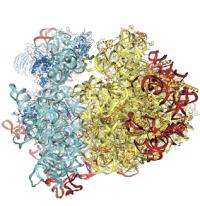The eukaryotic ribosome unveils its structure

One year after the Nobel Prize in chemistry was awarded for the discovery of the bacterial ribosome's atomic structure, French researchers from the Institut de Genetique et de Biologie Moleculaire et Cellulaire have determined the first structure of a eukaryotic ribosome, that of yeast. This work, published on 26 November 2010 in the journal Science, puts an end to the frantic international race to discover the structure of this imposing cellular machinery.
The eukaryotic ribosome is at present the largest biological asymmetric molecule whose structure has been elucidated by crystallography. These results provide new research leads to enhance our understanding of the dynamics of protein synthesis in order to develop new therapeutic compounds.
The ribosome, a complex “nanomachine”
The ribosome is a vital machine of the cell, which ensures protein synthesis from genetic information. It interacts with numerous proteins and plays a key role in various cellular processes. Researchers have for many years been attempting to determine its atomic structure, a considerable challenge given its size and complexity. The bacterial ribosome has a structure similar but not identical to that of the eukaryotic ribosome (non bacterial). It is smaller, only 2.3 MDa, compared to 3.3 MDa for the eukaryotic ribosome) but has the same general organization into two subunits. In 2009, the Nobel Prize in chemistry was awarded to the researchers who were the first to determine the structure of the bacterial ribosome. Since then, there has been a frantic race to elucidate the structure of its eukaryotic counterpart.
Determining the structure of the eukaryotic ribosome: a difficult task
To determine the structure of the eukaryotic ribosome, the researchers focused on that of yeast, an ideal model organism already known and widely used in biology. With a mass of around 3.3 MDa, the eukaryotic ribosome is 40% larger than its bacterial counterpart. After a long molecular purification and stabilization process, the Strasbourg researchers finally obtained its atomic structure with very good resolution of 0.415 nanometers, i.e. a resolution on the molecular scale. The team from the Institut de Génétique et de Biologie Moléculaire et Cellulaire confirmed the existence of movements, not only within the ribosomal subunits but also between each other, highlighting the oscillatory dynamics behind the protein synthesis mechanism.
Promising results
The team's next objective is to determine the structure of other eukaryotes' ribosomes and further improve the resolution of the results so as to obtain a description of the ribosome and of the mechanisms that take place therein at the atomic scale. Elucidating this structure will facilitate our understanding of structure/function relations at the atomic scale and provide the molecular bases to investigate the unique characteristics of eukaryotic translational machinery. Such a description would also provide precious information for the development of new therapeutic compounds targeting viruses, protozoa (malaria, sleeping sickness, toxoplasmosis, etc.), fungi and bacteria. In fact, blocking the ribosome of these organisms would block their activity as a whole.
More information: Crystal structure of the eukaryotic ribosome. Adam Ben-Shem, et al. Science, 26 November 2010.
Provided by CNRS















